Just three days before we published this issue, YouTube removed “Planet of the Humans” from its site. Here is Michael Moore’s response: https://www.facebook.com/mmflint/posts/10156931713771857 . The film is available on Vimeo at this link: https://vimeo.com/423114384. UPDATE: the film has been restored to Youtube, at this link: https://www.youtube.com/watch?v=MrOcBdnC3kw&feature=emb_logo
THE FILM I’VE WAITED FOR…
When I first heard about the Michael Moore-produced documentary film, “Planet of the Humans,” I was skeptical. I expected yet another knee-jerk, mainstream faux-environmental screed about the evil nature of anyone affiliated with the fossil fuel industry; another homily on how we can save ourselves and our planet by driving a Prius and carrying reusable grocery bags. When I heard that the film actually challenged the conventional wisdom on renewable energy, and exposed the hypocritical influence of Big Corporate Money on the mainstream environmental movement, I was incredulous. And wary.
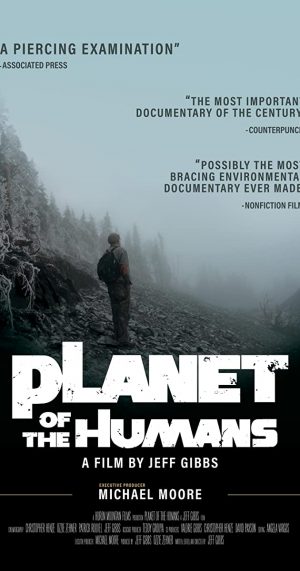
When we finally turned on YouTube and watched Planet of the Humans, on Earth Day 2020, I could only say, out loud to the television screen, “WHAT TOOK YOU SO DAMN LONG?” I would not have predicted that Moore and director Jeff Gibbs, who spent their careers attacking conservative positions on gun rights and corporate greed would aim their sights at their liberal allies.
What I could have predicted, and what didn’t take long at all to occur, was the immediate, negative response from mainstream environmentalists, former Michael Moore allies, and the special interest groups invested in the renewable energy industry. The attacks were brutal, unforgiving, and sometimes bordered on the hysterical. Some critics demanded that the film be banned.
And then, also, some of the criticisms were absolutely fair.
After watching the film, then reading the plethora of attack reviews, then referring back to the film producer Gibbs’ response to those criticisms, I felt genuinely conflicted. Are Gibbs and Moore being unfairly attacked by an intolerant, self-righteous environmental constituency which refuses to acknowledge its own unsupportable lockstep views? Or did Gibbs and Moore shoot themselves in the foot, injecting dated information, agenda-driven interviews, and biased misinformation into their film, while pursuing a story with an honest premise?. To me, it’s a bit of both.
On the one hand, Planet of the Humans (henceforth “PotH”) explores and exposes issues that should have been given front page coverage years ago. It reveals hard, unpopular truths that had never before reached such a large audience (as of posting date, the film had been viewed at least 8.3 million times on YouTube).

PotH unflinchingly exposes “green” efforts to promote and embrace a “renewable energy” economy that it insists will allow our society to control climate change, while also permitting us to maintain our lifestyle.
For years, some mainstream green organizations have even claimed that a Green Economy can further enrich our excessively consumptive society and provide us with even more of the material wealth so many think we need. That message has been clear from the outset. Less than 20 years ago, the environmental power house, the National Resources Defense Council (NRDC) was already claiming we could have it both ways when its executive director said this:
“Reducing global warming pollution will have an imperceptible effect on economic output… We can stave off the biggest environmental and humanitarian crisis without disrupting economic growth.”
In other words, nobody really needs to change their lifestyle. We can be equally consumptive, but in a way less impacting to the planet. Their message was and is anathema to the truth, and that is the ultimate point PotH was trying to make.
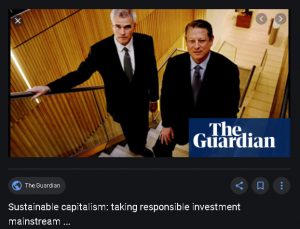
(At the same time, NRDC’s words were prophetic for some. Just ask Al Gore. He’s done quite well “going Green” and makes a few appearances in the film. A quick Google search of NRDC and Al Gore gave me 50,000 hits.).
Second, PotH connects the dots between mainstream environmentalism and Big Money. Gibbs and Moore expose the mostly unreported hypocrisy that has existed for years between mainstream environmentalism and the world’s wealthiest corporations and individuals. Many of those mega-billionaires — including industrialists, venture capitalists, bankers, financiers, and hedge fund managers— sit on the boards of directors of the nation’s largest and most powerful environmental organizations. These boards make policy. They set the agenda for mainstream environmentalism and direct its future. We’ve been documenting those kinds of mutually beneficial associations in The Zephyr for years.
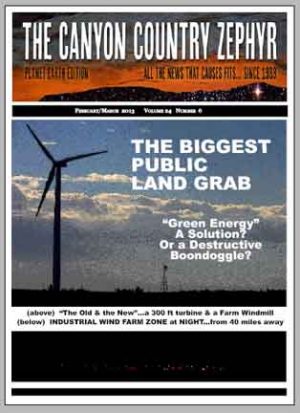
And so, I have to admit I felt a tinge of personal vindication. The Zephyr has been pursuing these troubling contradictions and ethically-challenged alliances, on our own, and with very little support, for almost two decades.
In the late 90s I still lived under the delusion that environmentalism was an idealistic, grass-roots, bare-bones movement, motivated by honest concern for the planet’s future. Like Jeff Gibbs, I had been a full-fledged, card-carrying environmentalist, who supported all the politically correct strategies that he and I now question. When I discovered how badly that idealism had been corrupted, via the influence and money of some of the world’s wealthiest men and women, it was difficult to accept. But over time, the evidence bore out the hard and disturbing truth.
And so, personally, I felt like PotH was telling my story too.
BACKLASH & DEJA VU
But now in the wake of its Earth Day release, Planet of the Humans has generated a firestorm of outrage and denunciation, from the same kinds of groups, that I have weathered, but on a far grander scale. The filmmakers were accused of deception, and outright lies, of pandering to the fossil fuel industry, and preaching “eco-fascism.”
Some, apparently led by the producer of the documentary film Gasland, Josh Fox, led efforts to see the film banned, calling it “dangerous.”
Such demands don’t surprise me. I can only wonder how things have changed since the days when “progressives” welcomed an honest debate and discussion. The great journalist Edward R. Murrow once said, “We must not confuse disloyalty with dissent.” And yet, eliminating dissent has become standard operating procedure for many progressive/environmental organizations who take issue with an opposing perspective.

It’s almost their mantra...Don’t debate the issue. Just censor it.
(Note: I’m using the word “censor,” but I understand the argument that Youtube is a private company and that, when the company removes videos from its site that it no longer supports, it isn’t technically “censorship.” In this case, though, where a video would be removed in order to deliberately shut down a conversation about its content, and considering Youtube has created an impression of representing a broad variety of viewers and political perspectives, it seems to me that “censorship” is the closest word to describe the motives at play.)
The Zephyr has experienced precisely this kind of assault on our publication’s integrity and honesty over the years. We were once called “the best newspaper in the world,” by mainstream Utah environmentalists, until we disagreed with them on issues we thought were critical to discuss. Our fall from favor is well-documented.
So we, like Gibbs and Moore, know how swiftly opinions can shift in this highly polarized world.
THE FLAWS & THE FACTS
On the other hand… there are indeed mistakes, missteps, and perhaps worst of all, emotion-driven manipulations that detract from PotH’s core message. For me it wasn’t that they got their facts wrong, as much as it was the way in which those facts were presented.

Some of the information, especially re: solar energy, was dated and the film would have better served its cause had it presented those facts in some form of a chronology. It left PotH wide-open to the assuredly hostile critics they knew would be waiting to pounce.
Some of the information has been attacked for being misleading. For example, the film shows an abandoned solar installation that had been abandoned and left to decay. Critics claim that the panels were soon replaced by an even larger and more efficient solar farm. What’s not mentioned is what once lay beneath those decaying panels in the first place. A thriving desert ecosystem was completely denuded of life to house those panels. Ask the people of Spotsylvania what a 6000 acre solar project does to a forest…
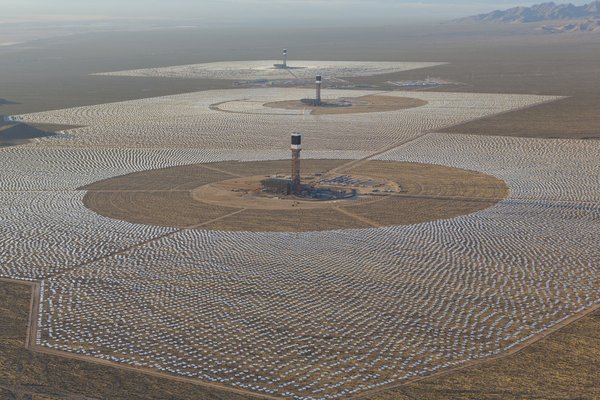
I was annoyed by some of the rapid-fire video sequences. It’s a filmmaker’s way of throwing many images at the viewer, in split second flashes, to drive a point home. In this case they usually included lots of heavy equipment destroying land and everything on it, with smoke and fire,and very loud dissonant music in the background. It’s visually disturbing, and I suppose that’s the goal, but it contributes little to the viewers’ knowledge of the crisis they’re trying to reveal.
There was also some gruesome, gratuitous video footage of animal cruelty that felt manipulative to me and unworthy of the film’s true purpose. This was what I expected from Michael Moore. I will always be haunted by the “gotcha” interview with a severely diminished Charlton Heston in the final minutes of “Bowling for Columbine.” It was common knowledge that Heston, who had been a spokesman and leader of the NRA, was suffering from dementia and was consequently outmatched by an aggressive and unsympathetic Michael Moore. The moment left a bad taste and created a negative backlash against the film and its outspoken producer.

Likewise, the interviews with “experts” in PotH often played like an updated version of a Mike Wallace/60 Minutes ambush interview. And they felt dated as well. When Gibbs interrogated environmental icons like Bill McKibben or Robert F. Kennedy, Jr, I expected to see a tagline letting us know when the conversation occurred. But it never happened. His “gotcha” moments, especially with McKibben, were confusing, especially when I later discovered that he had denounced bio-mass as an acceptable form of “renewable” energy four years before the film premiered for wide distribution on YouTube.
On the other hand, perhaps the reason that environmental icons like McKibben and Kennedy looked so startled was that they had rarely if ever been asked tough questions, especially from an informed interviewer who was perceived to be, until that moment, a “friendly face” in the crowd.
And again, I hope it doesn’t sound self-serving, but we’ve experienced the same kind of reaction from environmentalists who once considered The Zephyr to be the “print arm” of their own cause. When we went from what almost felt like pandering to these organizations, to asking tough questions, we were quickly re-labled as traitor/pariahs in the relative blink of an eye.
There have been other criticisms of the film. To hear them and to read the response from Director Jeff Gibbs, I’ll direct you here, to the film’s “fact sheet” and its “FAQs.”
FACT CHECK BIBLE: https://planetofthehumans.com/fact-check-bible/
FAQs: https://planetofthehumans.com/faqs/
You can watch the film here: https://planetofthehumans.com or on YouTube
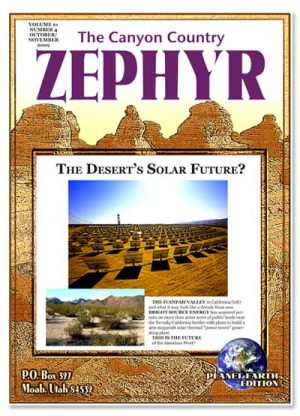
But what the critics studiously avoid is the inescapable fact that, even with improved efficiency, real renewable energy in 2020 (i.e, solar and wind) still constitutes a tiny fraction of the country’s electrical needs. And the idea that solar and wind can become our sole source of power in 20 or 30 years is ludicrous. NASA’s James Hansen, a hero to the environmental movement, said just a couple years ago:
“The people who argue for all renewables think that, well, if we can go from 0% to 10% to 20% renewable then we’re on the way and then it will get easier and we’ll get to 100% …if you look at the engineering, it’s actually the opposite. When you to 20 or 30%, then it gets harder! Not easier! …because of the intermittency of the renewables.”
Here are some statistics that aren’t dated at all—they’re less than eight months old. They are derived from analysis of the latest issue of EIA’s “Electric Power Monthly” (with data through August 31, 2019):
Renewable energy sources (i.e., biomass, geothermal, hydropower, solar, wind) accounted for 18.49% of net domestic electrical generation during the first eight months of 2019…Solar, including small-scale solar photovoltaic (PV) systems accounted for a bit more than 2.7% of total electrical output.
In addition, U.S. wind-generated electricity increased by 4.4%, accounting for 6.94% of all electricity generated.
While it’s true that the costs and effectiveness of renewable energies like solar have improved, the scale of their goals as proposed by its advocates is staggering. To create the kind of renewable grid they envision will require an unprecedented global commitment. In addition to the wind and solar facilities themselves (to be built in unimaginable numbers), we will need to dramatically expand our transmission infrastructure and develop a long term means of storing the produced electricity on a global scale.
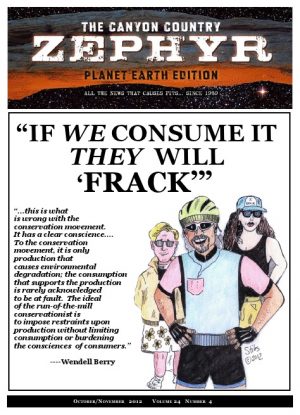
Consequently, it will necessarily mean the mining and processing of massive quantities of natural resources–cobalt, copper, lithium, quartz–to build the panels and turbines and corresponding infrastructure, and the destruction–the denuding, in fact— of untold hundreds of thousands, perhaps millions of acres of land, both public and private, from the Pacific Coast to the the Atlantic, (not to mention the rest of the planet). The staggering growth of these industries will threaten whole swaths of pristine desert, undeveloped forests, wide prairies and all the varieties of wildlife and plant species that call those spaces home.
It will literally change the face of the American landscape.
Just last week, the Department of Interior gave its final approval for the construction of the largest solar facility in the nation. According to the Las Vegas Sun, “The $1 billion Gemini Solar Project will extend across 7,100 acres in the Mojave Desert, making it the largest solar project in U.S. history and the eighth largest in the world.” Despite environmental concerns for wildlife habitat, its investors insist they can “mitigate” those concerns. And if it were only this project, perhaps mitigation would be feasible. But this isn’t a one-trick pony.
What’s happening at Las Vegas, and what’s already been developed across the country in the form of solar facilities and wind “farms’ is just a tiny fraction of what is being planned long-term. When Blade Runner 2049 premiered a couple years ago, the film opened with this scene.
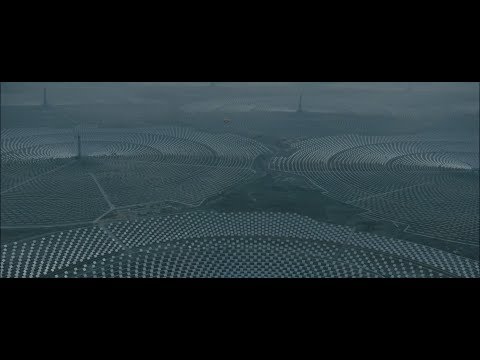
THIS is the solution being proposed as a way to save the planet. But it’s a lie. You can’t heal industrialization with ever greater industrialization. Yes, solar panels are more efficient than they were ten years ago. But scaling these technologies to keep pace with America’s insatiable need for energy would be a dystopian prospect.
THE HYPOCRISY…BIG GREEN & BIG MONEY
(and some Zephyr History)
As for the hypocritical alliances between the country’s wealthiest 1% and the environmental industry (and that is what the enviro movement has become), the green movement’s efforts to deny or equivocate about those kinds of high dollar influences is laughable.
While McKibben and other environmental leaders have vigorously objected to being linked to the very industries they claim to oppose, I know for an absolute fact, via twenty years of Zephyr research and investigation, that the film’s examples of those bewildering, contradictory, unholy alliances are embarrassingly common. The leaders of these organizations know it.

Our own efforts to reveal such hypocrisies go back to The Zephyr’s 2008 10,000 word expose’, “The Greening of Wilderne$$–How the Mega-rich are Co-opting Environmentalism and Turning It into Big Business.”
Since then we have posted tens of thousands of words on the subject. Here are links to a collection of those articles, assembled in one folder, in this issue….
In PotH, Bill McKibben is asked to identify his funding sources and in a long, awkward minute, he is unable to produce them. Since the film debuted, McKibben has denounced PotH and implied that he and other environmental organizations would never compromise their values to take money from tainted donors. But if he and others truly want to clear the air, they have the ability to do so.
Almost all of these organizations are non-profit, 501 (c) 3 entities and operate under IRS rules; consequently, they are NOT obligated to share their donor lists with anyone. But the organizations are not required to hide the names either; all McKibben and his fellow environmental leaders need to do is open the books–let all of us see who keeps them solvent. The donations must be substantial to allow officers to work with salaries trending to the hundreds of thousands of dollars, with payrolls in the millions.
In the twenty years The Zephyr has pursued the donor information of these organizations, not one of them has offered to provide it.
And yet the revelations in Planet of the Humans come as a shock to the millions of new viewers who are hearing them for the first time. These tales of hypocrisy and greed gone green have been around for years. But it took the power of Michael Moore’s name and reputation to finally reach the masses of humans who should have been allowed to hear all sides of the debate a long time ago.
How is that possible?
THE CORE MESSAGE…EXACTLY
(even the critics agree)
Finally, it’s important to consider what the film’s intent was, and how its multitude of critics have now interpreted it to be. To me, the heart of the question was not whether a solar panel has increased its efficiency from 8% to 12%, or whether a rock concert ran exclusively on renewable power, or whether an electric car sucks its energy from a fossil-fueled source.

In an interview for The Hill, Michael Moore said this:
“The real point here is it’s only your friends who can tell you when you’re messing up, when you’re doing wrong…“We are the environmental movement, we’ve been involved, Jeff and I, since the first Earth Day … if we can’t say to each other ‘Hey, look, if we’re not winning then why don’t we have the discussion of what we need to do.’”
Oddly, even the most negative reviews buried the most important truths of the film in their own critiques. For example The Mail & Guardian wrote that PotH, “can be generously described as a mess. It’s sloppily reported, shoddily produced and politically confused.”
But later they concede that, “…Gibbs does tell a few important truths; the kind you’re unlikely to find in another environmentalist manifesto with such a large audience. His critique of green growth, for one, is welcome at a time when profit-hungry corporations such as Blackrock are earning praise even from some environmentalists for making voluntary and wholly insufficient environmental pledges. And he’s right to criticise the sometimes nauseating coziness between ‘Big Green’ nonprofit organisations and some of the financial institutions and corporations driving the environmental crisis.”
In another withering attack, a blogger named Emily Atkin writes, “This movie repeatedly claims that humans are better off burning fossil fuels than using renewable energy.”
That’s simply not true. PotH is a work of frustration and despair, and is not in any way an endorsement of Exxon Mobil. It shows its viewers that the “solutions” mainstream environmentalism are boasting about, investing in, and spoon-feeding to us are not working. The fossil fuel companies may approve of the film on some level, but the truth is, those same companies are now heavily invested in renewable projects as well.
(Ms. Atkin also inexplicably complained that Gibbs “interviewed nine experts to support your three main points (I know, I counted). How is it even possible that two of them are named Richard, and two of them are named Steven? Approximately 45 percent of interviewed for this film are named Steven or Richard. How?”) A ‘cute’ comment perhaps, but not informative.
“But much as a broken clock is right twice a day, there’s a tiny kernel of truth buried deep under the mountains of outdated disinformation in Planet of the Humans. There are real, thorny questions about our low-carbon future that deserve to be debated in public: questions about public land use, the supply chains that the renewable energy industry depends on, climate crisis profiteering, and more. Gibbs offers no guide to addressing any of these.”
Here, the critic seems to understand the truth, but faults the film for not providing solutions, as if that’s the responsibility of the filmmaker in the first place. That sentiment is echoed more succinctly, and perhaps captures the essence of the negativity better than anyone, in this comment. The writer, Neal Livingston, a self-described “creative activist,” complained:
“Shame on these filmmakers for making a film like this, full of misinformation and disinformation, to intentionally depress audiences, and make them think there are no alternatives.”
Mr. Livingston, of course, builds wind turbines for a living.
Variety came closer to ‘getting’ the film than most. They wrote, in part:
“With our species’ population having skyrocketed in the last 200 years, we are simply in denial that mankind’s needs are exhausting Earth’s resources. ‘Infinite growth on a finite planet is suicide,’ (Gibbs) says, as bleak footage of rampant deforestation…provide just one vivid proof. There is no obvious solution, save a massive scaling-back that capitalism-driven societies don’t even want to think about.”
Ultimately, Gibbs and Moore are condemned for their bleak, desperate assessment of the planet and our effect on it, which was precisely what they intended. In more critiques than I can count, Gibbs/Moore find themselves being faulted for failing to offer solutions, for letting us feel hopeless and depressed.
And, as is the fashion these days, they’ve been labeled “eco-fascists” for even expressing their concerns about over-population and over-consumption. The critics imply that the film advocates population control as a last resort to save the planet. But it’s not true and that’s why the film’s frustration and despair cut so deeply and painfully into the psyche of the viewer.
The producers don’t offer a way out, but they want us to know that the strategies being initiated and the promises currently being made are not going to work. Gibbs/Moore don’t know the answers, but at least they’re asking the right questions. These are the “uncomfortable truths” Al Gore and honest environmentalists and anyone who genuinely cares about the future should be talking about— openly and without fear of retribution, or the threat of censorship. Perhaps our most dangerous and self-destructive behavior is the need to cling to False Hope.
As of our publication date, the film still isn’t available on Youtube. It is available on Vimeo at this link: https://vimeo.com/423114384. You can read more about the film, and its removal, on the Planet of the Humans website.
Jim Stiles is Founding Publisher and Senior Editor of the Canyon Country Zephyr.
To comment, scroll to the bottom of the page.
Zephyr Policy: REAL NAMES ONLY on Comments!
Don’t forget the Zephyr ads! All links are hot!


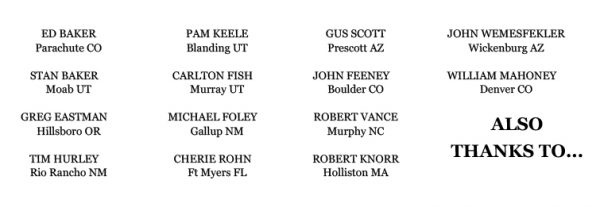

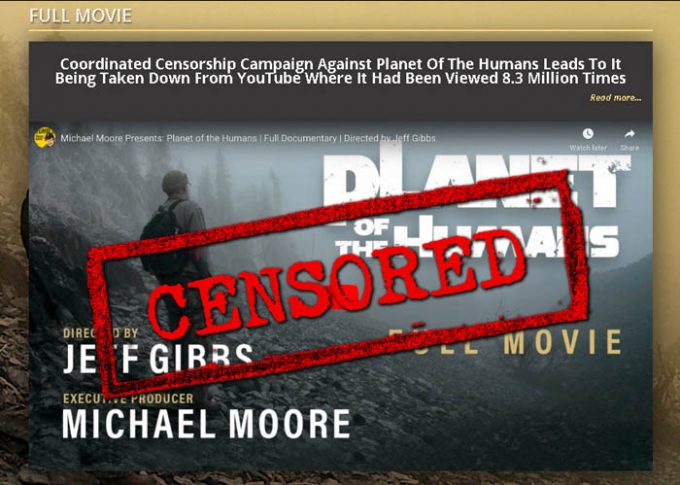







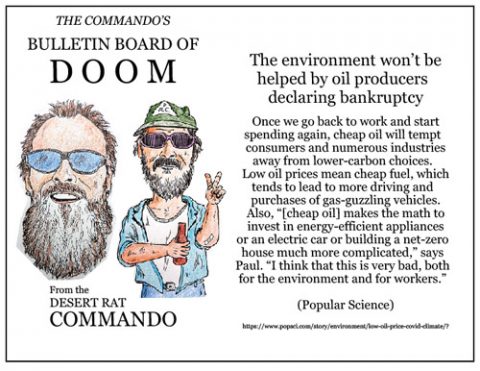
How fascinating–inevitable–and no surprise. It’s fascinating because of the reasons you outline, that Moore and Gibbs would look in the mirror of destruction and see themselves. It’s inevitable because you can only look in the mirror for so long without seeing yourself. And it’s no surprise that the powers-that-be want that mirror banned. As I write (June 1, 2020), American cities are going up in flame because the powers-that-be have been promoting racism for, what, 300 years? The riots will eventually end and the racists will keep on hating. I think you can expect the energy industry to continue it’s march of ‘progress’ until the planet of the humans experiences the grandaddy of all COVID-nineteens. I’d like to peddle hope and I appreciate that Barack Obama does so, so thoughtfully, but John Lennon had it right when he called out “No short haired yellow bellied son of Tricky dick is gonna soft soap me with just a pocket full of hope….just gimme some truth!” Seems like the Zephyr is the closest thing to that truth any of us are likely to find.
Planet of the Humans is doing so well because people instinctively get the basic messages of the film:
Wind and solar energy cannot replace fossil fuels because major industrial processes (think blast furnaces and the like) still require them. It’s just a breath of fresh air to see enviro messaging revealed as a big lie, trying to get us to think that end-user energy use (homes and cars) is the whole problem when it’s just the tip of the iceberg.
The global hyper-rich (these are individuals whose names will not appear on non-profit tax returns regardless of the donation amount) are in fact responsible for major funding of environmental organizations.
Civilization’s impact on the planet is a function of consumption and population. And you’re just not going to see a meaningful reduction in total impact while total population is still increasing.
Show me any Sierra Club policy advocacy to the effect that we Americans need to reduce our lifestyle to somewhere near India’s per capita consumption and reduce our population at the same time. THIS is why Planet of the Humans is winning on messaging and why so many powerful people want to bury it.
Thanks Doug Meyer… you nailed it.
This article and another one that appeared in the previous issue was disheartening.We try to do the best we can with what little we have, in sending donations to environmental and humanitarian (same thing, really) organizations. We do our homework. We check out Charity Navigator and other such sites to try and make sure that our donations are doing some good.We scope out those high CEO salaries and are amazed. We are DISAPPOINTED in many of those mainstream organizations and articles read here and in other places cement that idea.Some of the big companies support environmentalism just to make themselves look good. There’s something like a Philanthropy Index (that may not be the correct title) that is more than a little eye-opening. Exxon still owes those Alaskan fisherman for damages caused by the Exxon Valdes. OK, I apologize for venting like this. I’m just some old (white) man trying to make some sense out of things. Thank you Jim, Tonya, and the Zephyr. ‘Do Without. Use Less. Re-Use, and Don’t Breed!”